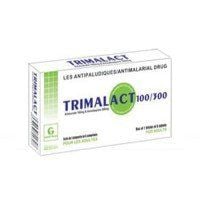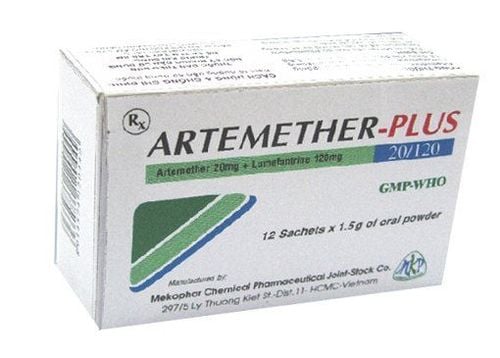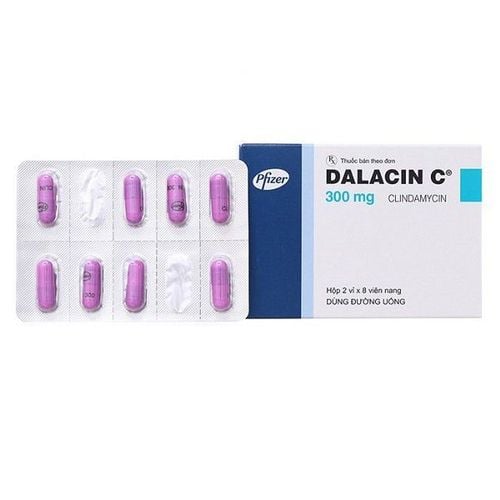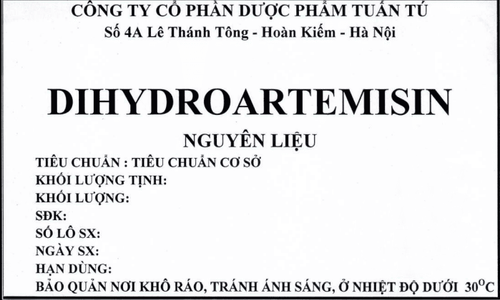This is an automatically translated article.
Malaria is an infectious disease caused by the Plasmodium malaria parasite, mainly transmitted by the Anopheles mosquito species with characteristic symptoms such as fever (cyclical), chills, sweating, anemia. hemolysis and splenomegaly.
1. Malaria Parasite Overview
Malaria parasite belongs to the genus Plasmodium, with 5 parasitic strains including:
Plasmodium Falciparum: This is the main cause of disease with about 70-80% of malaria cases in Vietnam. The malaria parasite Plasmodium Falciparum almost only grows well in hot and humid climates. Plasmodium Vivax: Less common, with about 20 - 30% of cases, more often found in cold climates. Plasmodium Malaria: Rare in Asia due to poor growth characteristics in hot and humid environments. Plasmodium ovale: This species has not been discovered in Vietnam. Plasmodium Knowlesi: This is a newly discovered species, is a species of monkey malaria parasite capable of causing disease in humans. Vietnam currently has 3 main strains of the malaria parasite, P. falciparum, P.vivax and P.malariae. Up to now, the method of detecting the shape of malaria parasites by blood smear and giemsa staining (Romanovski) technique is still used to diagnose and distinguish the shape of parasite species of the genus Plasmodium.
When sucking blood, the female Anopheles mosquito carrying the disease will transmit the sporozoites, along with the anticoagulant in the saliva, to the human host. Thus, the development and pathogenicity of the malaria parasite mainly involves 2 hosts:
In the mosquito body: When the mosquito sucks the blood of an infected person, it will inadvertently nurture a quantity of male gametocytes. and females, producing sporozoites in large numbers, concentrated mainly in the salivary glands of mosquitoes. In the human body: Through the bites of mosquitoes, the parasite enters the human body. After about 2-3 days circulating in the circulatory system, they will gather to grow in numbers in the liver.
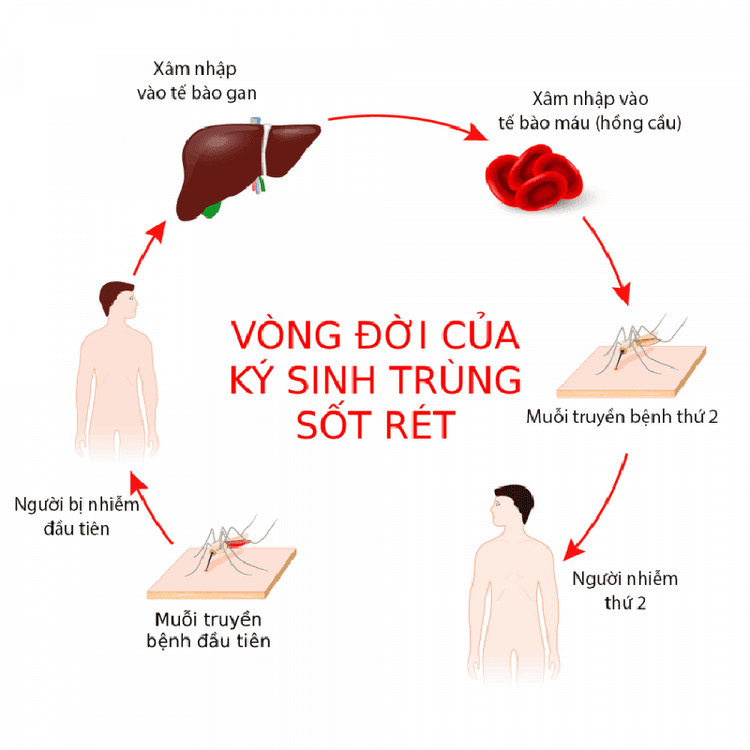
Quá trình phát triển và gây bệnh của ký sinh trùng sốt rét chủ yếu liên quan đến 2 ký chủ muỗi và con người
2. The life cycle of the malaria parasite
The basic life cycle of the malaria parasite is the same in all Plasmodium species.
Transmission begins when an Anopheles female mosquito sucks blood containing spores from a person with malaria. The gametes inside the mosquito begin to reproduce and produce sporozoites after about 1-2 weeks. When a carrier mosquito bites another person, the sporozoite is injected inside the body, quickly reaching the liver and entering liver cells. Here, the sporozoites mature into schizonts. These schizonts then break apart and release the merozoites. The multiplication of the malaria parasites in the liver is called the pre-erythrocytic cycle. The spores migrate into the red blood cells and begin the process of clonal replication, which is the erythrocyte cycle. In it, the spores develop into trophozoites and then mature into schizonts. These schizonts rupture and release the sporozoites. After 48 to 72 hours, they rupture red blood cells and release the sporozoites into the plasma, causing clinical symptoms of malaria. Some can differentiate into sexual bodies (gametes) while still in the erythrocyte stage. When biting a human, the mosquito sucks the male and female gametes, starting the sexual reproduction process, called the spore cycle. In the mosquito's stomach, the male gamete penetrates the female gamete to produce a zygote. The zygote then mutates, elongates, is able to move, and develops into a mobile egg. Motile eggs pass through the outer surface of the mosquito's stomach wall and develop into cysts. The follicular body develops and ruptures, releasing the sporozoites. The sporozoites migrate to the mosquito's salivary glands, where they are ready to be transferred to a new host and continue the malaria life cycle. For some species of malaria parasites, such as Plasmodium vivax and Plasmodium ovale, sporozoites exist in an inactive phase called the hypnozoites. If left untreated, the dormant form can persist in the liver for weeks or even years and will cause a recurrence of symptomatic malaria by entering the bloodstream. The dormant form is not nearly as responsive to most antimalarial drugs used to kill parasites in the blood.
The pre-erythrocytic cycle (hepatic phase) of the malaria life cycle will not occur if the disease is transmitted by blood transfusion, needle sharing, or congenital causes. Therefore, these modes of transmission do not cause latent symptoms or recurrence.
Clinical symptoms of malaria appear when the sporozoites are released into the plasma during the erythrocytic phase. If severe, hemolysis can lead to anemia and jaundice, which burden the spleen to phagocytize infected red blood cells. Anemia is often more severe with a chronic Plasmodium falciparum infection or a chronic Plasmodium vivax infection.
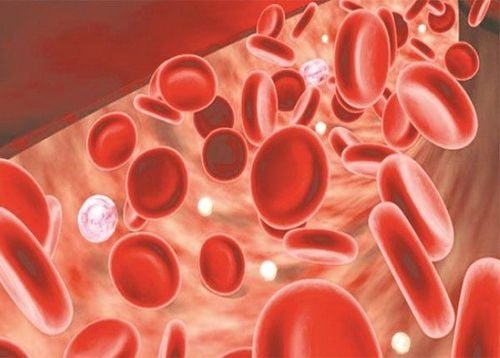
Tình trạng thiếu máu thường nghiêm trọng hơn nếu nhiễm ký sinh trùng sốt rét Plasmodium falciparum hoặc nhiễm Plasmodium vivax mạn tính.
3. Measures to prevent malaria parasites
In general, malaria is a dangerous disease that has no specific treatment and vaccine. Therefore, disease prevention should be focused and proactively implemented with the following measures:
Limit the risk of exposure to mosquitoes: Maintain the habit of sleeping under a mosquito net, even during the day. In addition, you can apply cream, spray anti-mosquito, burn incense to repel mosquitoes or use a lamp to catch mosquitoes,... Clean living places: To limit places for mosquitoes to reside and lay eggs. Specific tasks that need to be done regularly are clearing grass, bushes, filling potholes, ducks' nests, turning upside down or covering items containing water such as rollers, dippers, tires,... Spraying chemicals Kill mosquitoes in the area: When there is a peak of malaria, especially in the rainy season, people should notify the authorities to spray insecticides in the area to prevent the spread of parasites. malaria virus. To ensure the safety of blood transfusion, the person receiving blood needs to make a specific and clear medical declaration, especially when living in a malaria area or having a history of infectious diseases. When symptoms are suspected to be caused by malaria parasites, patients need to be accurately diagnosed and treated as soon as possible to prevent complications and reduce the risk of death from malaria.
Vinmec International General Hospital is one of the hospitals that not only ensures professional quality with a team of leading medical doctors, modern equipment and technology, but also stands out for its examination and consultation services. comprehensive and professional medical consultation and treatment; civilized, polite, safe and sterile medical examination and treatment space.
Please dial HOTLINE for more information or register for an appointment HERE. Download MyVinmec app to make appointments faster and to manage your bookings easily.




